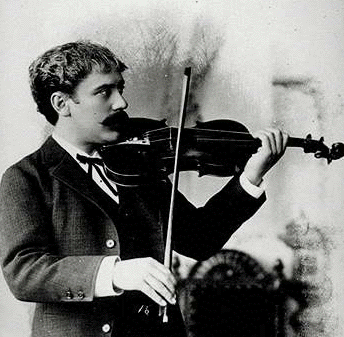The Green Violinist
Recently, one of the 24/7 news networks had a feature on the "green" movement in Hollywood that included an actress, who characterizes herself as having "the smallest carbon footprint possible," describing how the cast and crew eat off recycled plates, use old paper for their scripts, and ban plastic water bottles from the set.
Normally, I wouldn't think of the Hollywood crowd as conservative, in the traditional sense of the word. Maybe all of those lovely Christian Louboutin shoes and Zac Posen frocks provide years of wear and ultimately get recycled, but somehow I doubt it. All evidence points to the fact that the popular entertainment and fashion industries depend on their clientele - and larger audience beyond - wanting something new, different, exciting; in other words, exhibiting a chronic dissatisfaction with what they already have.
This consumerism plays to the deep insecurities of even the hottest starlet; i.e., if you are not dressed in the latest or dare to have some latent expression in your brow, you may not be admitted to the club-of-the-moment and the social set will ostracize you. Successful television shows (The Rachel Zoe Project comes to mind) are built around people - mostly women - having meltdowns over outfits and accessories, which seems to indicate an inordinate unease over their appearances and that of their clients. Fortunately, many of the celebrities themselves have disposable careers, and their attempts at recycling their fame - through queasy ventures like reality shows on their stints in rehab, extreme plastic surgery or repeated weight loss attempts - generally just strip them of whatever shreds of personal dignity remain.
But I digress: One under-appreciated aspect of classical music is that it is extremely "green." A violinist needs no electrical current; no plugs, no amps - just a violin, four strings and a bow outfitted with horsehair that has some rosin, made from the resin of a fir tree, on it. My own violin was made in Venice two hundred and sixty-eight years ago (I have been playing on it since I was eleven) and my principal bow is at least two hundred years old, making for a professional carbon footprint to challenge that of even the most eco-conscious Hollywood celebrity.
Many musicians bequeath their entire music collections - comprising etude books, concerti, short pieces, and chamber music - to libraries, conservatories or musician friends. I cannot recall ever throwing out a music score that I bought; additionally, I have inherited probably hundreds of scores. Granted, a soloist with orchestra often requires a new outfit for the occasion, but I can assure you that the orchestra's members - especially the men - have but few sets of formal concert clothes and will wear them for years, sometimes with the aid of black electrician's tape. (On second thought, this may be more a reflection of their earned income....)
Musicians are often chided, quite understandably, by contemporary composers because of our predilections for the music by old masters like Bach, Haydn, Mozart, Beethoven and Brahms. In their eras, however, there were great composers and then there were good composers, and the rest were mediocre or worse: for example, I can assure you that no sane orchestra conductor will program music by Antonio Salieri in preference to that by Mozart or Beethoven. The same is true today. There are several living composers I know whose music is not only creative and structurally contemporary but also beautiful and resplendent with subtle emotion, which helps to counter the often-pretentious, tricky and clinical works by others.
The best music reaches deep within the soul, whether in that of the composer, interpreter or listener, where - like a beloved friendship - it exists as an enduring and treasured relationship. I believe that the life-affirming qualities of this music remain timeless and, therefore, worthy of "recycling" for centuries to come.



















